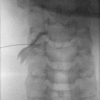Selective cervical nerve root blockade: prospective study of immediate and longer term complications
- PMID: 19193762
- PMCID: PMC7051454
- DOI: 10.3174/ajnr.A1415
Selective cervical nerve root blockade: prospective study of immediate and longer term complications
Abstract
Background and purpose: Selective cervical nerve root blockade (SCNRB) is a useful procedure for evaluating and treating patients with cervical radiculopathy. Reports of complications related to injections within the cervical nerve root foramen have raised serious doubts regarding the safety of this procedure. This study was performed to prospectively evaluate the safety of fluoroscopically guided outpatient diagnostic and therapeutic SCNRB.
Materials and methods: Eight hundred two consecutive fluoroscopically guided diagnostic and/or therapeutic SCNRBs in 659 patients were performed during a 14-month period (November 2006-December 2007) at affiliated outpatient imaging centers. Each examination was performed by 1 of 8 experienced procedural radiologists by using an anterior oblique approach, with the needle position confirmed with radiographic contrast before injection of an admixture of local anesthetic and steroid. All patients were assessed immediately and at 30 minutes following the procedure. Additionally, 460 patients were called by telephone 30 days following the procedure. All complications were recorded.
Results: Of the 802 attempted procedures, 799 were successfully completed. Three procedures were aborted due to anxiety, challenging body habitus, or persistent venous opacification observed during contrast injection and despite needle repositioning. There were no serious complications, such as stroke, spinal cord insult, permanent nerve root deficit, infection, or significant hematoma. There were 33 minor complications occurring within 30 minutes of the procedure; the most common was vasovagal symptoms. Three hundred forty-five patients were successfully contacted by telephone at 30 days postinjection, 9 of whom reported increased or new pain symptoms.
Conclusions: With our technique, fluoroscopically guided SCNRB is a safe outpatient procedure with a low immediate and delayed complication rate.
Figures
Similar articles
-
Must we discontinue selective cervical nerve root blocks? Report of two cases and review of the literature.Eur Spine J. 2013 May;22 Suppl 3(Suppl 3):S466-70. doi: 10.1007/s00586-012-2642-z. Epub 2013 Jan 18. Eur Spine J. 2013. PMID: 23328873 Free PMC article. Review.
-
Selective cervical nerve root blockade: experience with a safe and reliable technique using an anterolateral approach for needle placement.AJNR Am J Neuroradiol. 2007 Nov-Dec;28(10):1909-14. doi: 10.3174/ajnr.A0707. Epub 2007 Sep 28. AJNR Am J Neuroradiol. 2007. PMID: 17905892 Free PMC article.
-
Counterpoint: Conventional Fluoroscopy-Guided Selective Cervical Nerve Root Block-A Safe, Effective, and Efficient Modality in the Hands of an Experienced Proceduralist.AJNR Am J Neuroradiol. 2020 Jun;41(6):1112-1119. doi: 10.3174/ajnr.A6580. AJNR Am J Neuroradiol. 2020. PMID: 32522840 Free PMC article.
-
A posterior approach to cervical nerve root block and pulsed radiofrequency treatment for cervical radicular pain: a retrospective study.J Clin Anesth. 2015 Sep;27(6):486-91. doi: 10.1016/j.jclinane.2015.04.007. Epub 2015 Jun 4. J Clin Anesth. 2015. PMID: 26051825
-
A critical appraisal of the evidence for selective nerve root injection in the treatment of lumbosacral radiculopathy.Arch Phys Med Rehabil. 2005 Jul;86(7):1477-83. doi: 10.1016/j.apmr.2005.01.006. Arch Phys Med Rehabil. 2005. PMID: 16003684 Review.
Cited by
-
[Periradicular infiltration therapy : Clinical indications, technique and results].Radiologe. 2015 Oct;55(10):833-9. doi: 10.1007/s00117-015-0017-2. Radiologe. 2015. PMID: 26377920 German.
-
Oral prednisolone in the treatment of cervical radiculopathy: A randomized placebo controlled trial.J Res Med Sci. 2013 Mar;18(Suppl 1):S43-6. J Res Med Sci. 2013. PMID: 23961284 Free PMC article.
-
Transient quadriplegia after fluoroscopic-guided selective cervical nerve root block in a patient who received cervical interbody fusion -A case report-.Korean J Anesthesiol. 2010 Dec;59 Suppl(Suppl):S95-8. doi: 10.4097/kjae.2010.59.S.S95. Epub 2010 Dec 31. Korean J Anesthesiol. 2010. PMID: 21286472 Free PMC article.
-
Must we discontinue selective cervical nerve root blocks? Report of two cases and review of the literature.Eur Spine J. 2013 May;22 Suppl 3(Suppl 3):S466-70. doi: 10.1007/s00586-012-2642-z. Epub 2013 Jan 18. Eur Spine J. 2013. PMID: 23328873 Free PMC article. Review.
-
[Cervical disc herniation : Symptomatology, diagnostics, therapy].Orthopadie (Heidelb). 2025 Jan;54(1):26-39. doi: 10.1007/s00132-024-04582-8. Epub 2024 Nov 19. Orthopadie (Heidelb). 2025. PMID: 39560707 Review. German.
References
-
- Radhakrishnan K, Litchy WJ, O'Fallon WM, et al. Epidemiology of cervical radiculopathy: a population-based study from Rochester, Minnesota, 1976 through 1990. Brain 1994;117 (part 2):325–35 - PubMed
-
- Slipman CW, Lipetz JS, Jackson HB, et al. Therapeutic selective nerve root block in the nonsurgical treatment of atraumatic cervical spondylotic radicular pain: a retrospective analysis with independent clinical review. Arch Phys Med Rehabil 2000;81:741–46 - PubMed
Publication types
MeSH terms
Substances
LinkOut - more resources
Full Text Sources


